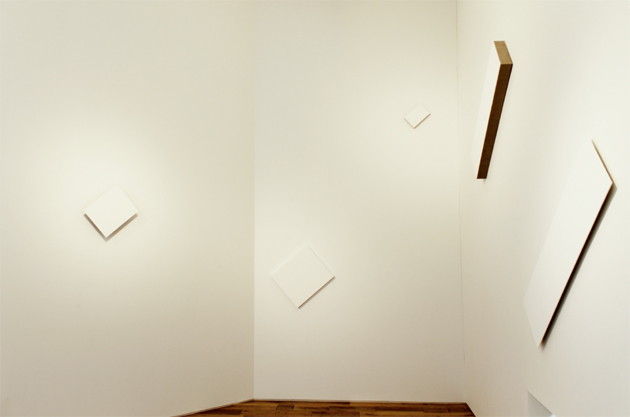「8 WHITE RECTANGLES」
会場:ギャラリーあしやシューレ(兵庫)
制作年:2014年
素材:様々な支持体にムードン、カゼイン、顔料
|
|
 |
 |
 |
the solo exhibition, "8 WHITE RECTANGLES"
Jan, 2014 at Gallery Ashiya Schule, Hyogo, Japan
material: pigment and casein on various materials
「8 WHITE RECTANGLES」
会場:ギャラリーあしやシューレ(兵庫)
制作年:2014年
素材:様々な支持体にムードン、カゼイン、顔料
メインの展示室の4面の壁に8つの白い矩形の作品が斜めに点々と掛けられています。それぞれの支持体の素材、厚みや側面の形状は様々です。麻や綿布をパネルやアルミに貼ったものや、MDF(木質繊維板)やアルミの上に下地剤が塗られています。平滑に磨かれた下地剤の上にカゼイン溶液と顔料を混ぜた塗料が吹き付けてあります。作品のそれぞれの形は、マレーヴィチの「eight red rectangles」という作品に描かれた赤い8つの矩形から引用されています。
マレーヴィチは20世紀初頭のロシアの作家であり、それまでの具体的な対象を描く事で成り立っていた絵画に反抗し、カンディンスキーやモンドリアンに並び抽象絵画を創造したアーティストの1人です。矩形などの幾何形態のみを絵画独自の構成要素として扱うことで自立的な芸術を追求する「シュプレマティズム」を提唱しました。作品「黒の正方形」や「白の上の白(い正方形)」などの極限まで要素を切り詰めた作品は、40年後のミニマリズムの思想的な礎とも考える事ができます。
私はこれまでギャラリー空間をひとつの支持体とみなし、その中に絵画に描かれる要素を配するように作品を配するという、空間をキャンバスに見立てた、絵画によるインスタレーションを試みてきました。今回、このあしやシューレの空間をキャンバスに、マレーヴィチ作品の8つの矩形と相似形をなす作品を展示する事で、ひとつひとつの作品が鑑賞の対象として存在しながら、同時にこのようなシンプルな作品が持つ現代における意味と力について再考を促す展覧会になる事を意図しました。
Eight white rectangular works are displayed obliquely and scatteredly on four walls of the main room of the gallery. The materials of the supports, the depths of the pieces, the shapes of the sides are all different. For example, some are wood panels or aluminum mounted linen or cotton, others are bare MDF or aluminum supports. All the works are painted base coating material and air brushed paint which is composed of pigment and casein after polishing the base coating material. The shape of each work is quoted from eight red rectangles of a Kazimir Malevich painting,“eight red rectangles”.
Malevich was a Russian artist in the early 20 century. He was one of the artists who resited painting concrete objects at the time and created abstract painting , alongside Kandinsky and Mondrian. He advocated “Suprematism”that pursued the art which establishes itself by treating only geometric forms (for example, rectangles) as components. You can think of his paintings that elminated extra elements to the utmost limits. such as ”Black square”or ”White on white”as an ideological basement of Minimalism, which was born 40 years later from the time of his paintings.
I have experimented with installation works of paintings, in which I install the paintings scatterly on the wall as if I had painted the elements directly on a canvas. This time, I intended each of my works be the objects to be appreciated, and at the same time, this exhibition stimulate the viewer to think again about the meaning and the power of these simple art works by installing the works which have the same shapes as eight rectangles of Malevich’s painting, compareing the walls of Ashiya Schule to a canvas.